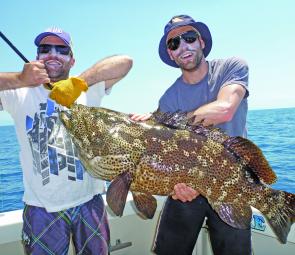The monsoon trough arrived early in the new year and has set the tempo for the next month or so. Expect plenty of rain and limited fishing opportunities as February tends to be our wettest and most volatile period in the tropics.
The rivers and creeks are receiving their annual flush out distributing new life in all directions and there’s not much you can do as an angler except to wait for a break in the weather. Sometimes this break will come days after a big rain and the water colour returns to some normality.
Fishing right upstream in the estuaries and creeks can be a good option especially with the barra back on the menu. Searching out those small feeder creeks, run-offs and nooks and crannies where bait such as mullet and prawns gather are ideal spots to work over; ambush predators such as barramundi and mangrove jack sure to be lurking nearby.
Live bait fish and prawns drifted down into the pool mouths can be dynamite and a variety of lures can have the same effect. It is a matter of experimenting with different lures and colours to establish a winning formula, but one can almost be assured a successful lure will have a good rattle creating a solid vibration in the dirty water. The run-out tides are best suited when exploring the far upper reaches of our local estuary and smaller creek systems.
In the major rivers that receive huge amount of fresh water, fishing the flats and channel edges closer to the main entrances can have its rewards on the incoming tides with a bit of salt pushing into the system. Reverting back to fresh dead baits can be extremely effective in the wetter months as live bait is often hard to come by. Water clarity is more than often very discoloured and turbulent and the strong scent of a fresh smelly bait will eventually be tracked down. Don’t be afraid to make up a mixture on your hook, which could include strip bait, squid and prawn. Fish tend be happy enough just to find a feed when conditions are tough. Javelin fish, mangrove jack, barra, blue salmon, flathead and trevally are all susceptible to such a cocktail.
Sourcing live bait can be a challenge and very time consuming when conditions are tough, and sometimes you are better off getting straight into the fishing with a pre-made supply of fresh dead baits.
As it can be at this time of year, there is a lot of fresh pouring off the coastline mountains that force the mud crabs closer to sea in search of saltwater. Inshore mangroves can also hold a good supply of the tropical delicacies. Placing pots tucked right up into mangrove pockets, which are supplied by a small run off drain, are as good as any spot to try. Good old fish frames are the locals choice of bait. If you can’t find the fish in numbers, a few mud crab are a superb substitute.
Offshore fishing can be quite challenging at this time of year for a variety of reasons. Our inshore reefs will most likely be inundated with too much fresh water and this can also be extended out towards the first edges of our outer reef systems. The demarcation line where the fresh meets the salt can sometimes extend as far as 20 miles offshore depending on how much rain has fallen. If this is the case, the fishing will be extremely tough.
Going as wide as possible to avoid any coastal influence is sometimes the only option. The extra cost of such an exercise is debatable because the reef fishing is probably at its slowest for the year. Generally you’ll have to make plenty of shifts plucking a few fish here and there at a time if you are working the reefs and rubble patches. Shipwrecks and very isolated structures in deep water are at times better value offering a variety of species including nannygai, gold spot cod, trevally, mackerel, and cobia.
First and foremost before you head offshore check the weather thoroughly as squalls are very common and can form without notice. We’ve already seen this first hand locally with small craft in particular getting into all sorts of difficulty being caught up these unpredicted conundrums.
Also when travelling our offshore waters, keep your eyes peeled as it can be like a minefield with a lot of debris on the surface. All sorts of foreign matter is strewn out to sea with a big wet including semi-submerged trees, 44 gallon drums and anything that floats.
The coming month is the hardest to predict because it is traditionally unpredictable and it all boils down to how much rain we receive. If the rain subsides for a period of time and the water clarity returns to some normality the fish will be on the move and this is when you jump on the opportunity.
Outside of this, it is also a good time to strip down your gear and do some maintenance on the boat and your tackle if conditions aren’t favourable. If the heavens do open up, not all is lost as this sets up a better fishing season ahead.
Reads: 1710
Gold spot cod are a common catch at shipwrecks and isolated structures.




